Good afternoon dear friends! Once all welcome to the site "Electrician in the House". Recently, the demand for LED products is constantly increasing. The use of innovative light sources is used in various sectors of the national economy.
New cars are equipped with LED lamps, houses, premises of enterprises and outdoor advertising stands are illuminated. They are used in spotlights, street and office lamps, as well as in many other human inventions.
concept does not even imply the amount of heat they give off, but has a completely different meaning. This is the visual effect of the perception of a light source by the human eye. As the color spectrum of light approaches the sun (yellow), the "warmth" of each lamp is determined.
You can also make an association with a candle flame, and you will immediately understand how this phenomenon is described. On the contrary, the bluish tint of light is associated with an overcast sky, a snowy night glow. This light evokes cold, pale images in us. But there is a scientific explanation for everything.
When a piece of metal is heated, it has a characteristic glow. At first, the color range is in red tones. As the temperature rises, the color spectrum gradually begins to shift towards yellow, white, bright blue and purple.
Each color of the glow of the metal corresponds to its own temperature range, which makes it possible to describe the phenomenon using known physical quantities. This helps to characterize the color temperature not as a randomly taken value, but as a certain heating interval until the required color spectrum is obtained.
The color spectrum of the glow of LED crystals is somewhat different. It differs from the possible colors of the glow of the metal due to a different method of its origin. But the general essence remains the same: a certain color temperature is required to obtain the selected shade. It is worth noting that this indicator has nothing to do with the amount of heat generated by the lighting device.
Once again, I want to note, do not confuse color temperature and physical temperature (amount of heat) that your lamp emits, they are different indicators.
Color temperature scale for LED lamps
Today's domestic market offers a huge range of light sources on LED crystals. All of them work in different temperature ranges. Usually they are chosen depending on the place of the intended installation, because each such lamp creates its own, individual look. The same room can be significantly transformed by changing only the color of the lighting in it.
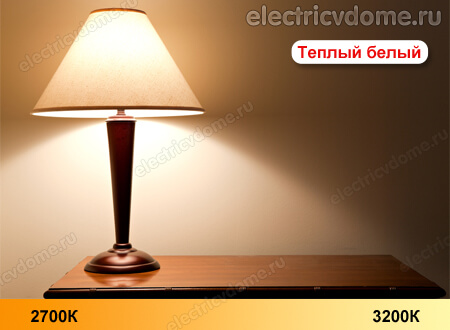
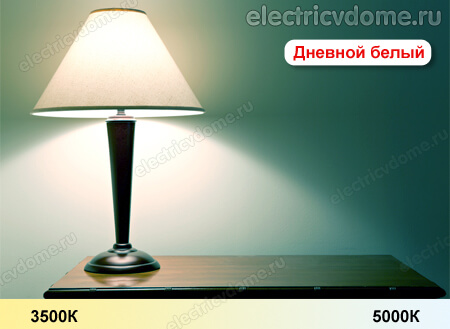
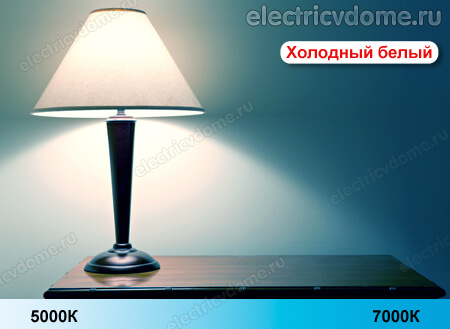
For optimal use of each LED light source, you should decide in advance which color is most convenient for you. The concept of color temperature is not specifically related to LED lamps, it cannot be tied to a specific source, it depends only on the spectral composition of the selected radiation. Each lighting device has always had a color temperature, just when standard incandescent lamps were released, their glow was only “warm” yellow (the emission spectrum was standard).
With the advent of fluorescent and halogen lighting sources, white "cold" light came into use. LED lamps are characterized by an even wider color gamut, due to which the independent choice of optimal lighting has become more complicated, and all its shades have become determined by the material from which the semiconductor was made.
Relationship between color temperature and lighting
A clear knowledge of the tabular values \u200b\u200bof this characteristic helps to understand what color will be discussed further. Each of us differs in his color perception, therefore, only a few can visually determine the coldness or warmth of the light flux.
The average indicators of a group of products operating in a given spectrum are taken as a basis, and the final choice of LED lamps takes into account the specific conditions of their operation (installation site, illuminated space, purpose, etc.).
Today, all light sources, depending on their range of glow, are classified into three main groups:
- - warm white light– work in the temperature range from 2700K to 3200K. The spectrum of white warm light emitted by them is very similar to the glow of an ordinary incandescent lamp. Lamps with such color temperature recommended for use in living quarters.
- - daylight white light(Normal white) - in the range from 3500K to 5000K. Their glow is visually associated with the sunlight in the morning. This is a neutral range luminous flux that can be used in apartment technical rooms (entrance hall, bathroom, toilet), offices, classrooms, production workshops, and so on.
- - cold white light(day white) - in the range from 5000K to 7000K. Reminds me of bright daylight. They illuminate hospital buildings, technical laboratories, parks, alleys, parking lots, billboards, etc.
| Colorful temperature | light type | Where applicable |
| 2700 K | light "warm white", "reddish white", warm part of the spectrum | Typical for conventional incandescent lamps, but also found in LED lamps. It is used in a cozy home interior, promotes rest, relaxation. |
| 3000 K | light "warm white", "yellow-white", warm part of the spectrum | Happens in some halogen lamps, also found in LED. Slightly colder than the previous one, but also recommended for housing stock. |
| 3500 K | daylight white light, white part of the spectrum | Created by fluorescent tubes and some modifications of LED lamps. Suitable for apartments, offices, public spaces. |
| 4000 K | light "cold white", cold part of the spectrum | An indispensable attribute of high-tech style, but suppresses with its deathly pallor. It is used in hospitals, and in underground facilities. |
| 5000 K - 6000 K | light "daylight" "white-blue", daytime part of the spectrum | An excellent imitation of the day for working and industrial premises, greenhouses, greenhouses, terrariums, etc. |
| 6500 K | light "cold daylight" "white-lilac", cold part of the spectrum | Suitable for street lighting, warehouses, lighting of industrial facilities. |
It is clear from the above characteristics that low color temperature red dominates and blue is absent. When the temperature increases, green and blue colors appear, and red disappears.
Where can I find out about this option?
On the packaging of each lighting lamp, manufacturers indicate its technical characteristics. Among all other characteristics, such as power, voltage, mains frequency, it must be indicated (this applies not only to LED lamps). You should definitely pay attention to this main factor before buying a lamp.
By the way, this characteristic is displayed not only on the packaging, but also on the lamp itself. Here is one example, a 7W LED lamp with a temperature of 4000K. It is installed in my house, in the kitchen, it shines with pleasant daylight.
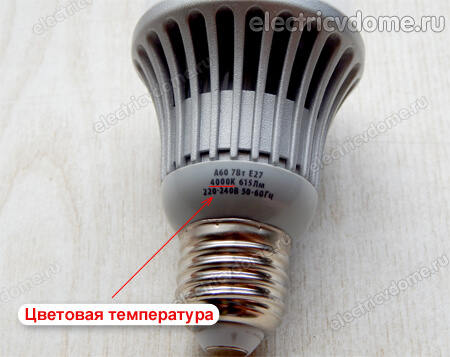
And here is another example of the designation on the LED spotlight for plasterboard ceilings, temperature 2800 Kelvin. Luminaires with this color temperature emit a warm light similar to an incandescent lamp and were installed in the bedroom at one of the objects.
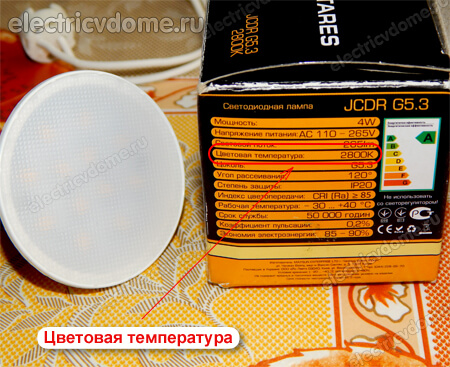
Which lamps to choose for the office
In the normative document SP 52.13330.2011 "Natural and artificial lighting" recommends the use of various radiation sources depending on their type, power, construction and characteristics of the luminous flux. It is prescribed to equip the premises of the housing stock with small and low-temperature "warm" light fixtures, and in the non-residential stock, install larger lamps of normal "white" light.
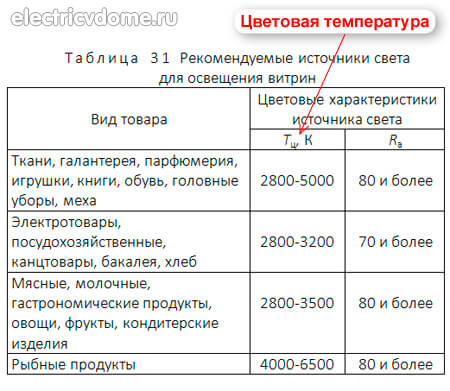
It has been proven that white lighting is optimal for the working process, since the part of the blue spectrum contained in it has a beneficial effect on a person, helps him to concentrate, accelerates the reaction and the working processes of the body. It is good to choose radiation sources from 3500K to 5600K, with white or neutral light, with a slightly bluish tint. Such lighting will make it possible to increase efficiency to the maximum mark.
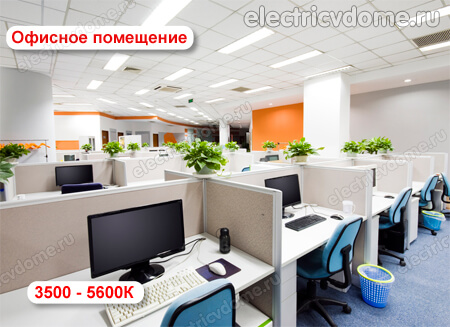
Both fluorescent and LED lamps are suitable, although the latter will give significant energy savings.
On the contrary, it would be a big mistake to install cold white light fixtures with a range close to 6500K in such a place. This will lead to rapid fatigue of workers, complaints of headaches and a sharp decrease in efficiency.
Which lamps are suitable for the home
In apartments and private houses, white light is not recommended. It is not necessary to place the same lamps everywhere, it is better to use individual recommendations for lighting equipment in such rooms. You can install white neutral lights in the kitchen, bathroom and hallway. Their temperature can vary from 4000K to 5000K.
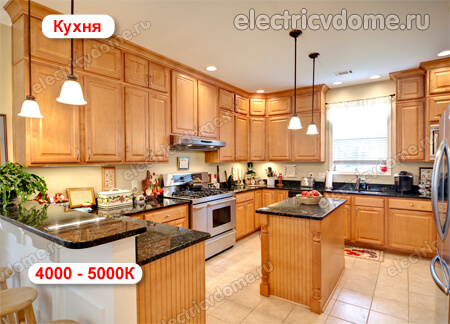
But for the bedroom, nursery and rooms where you relax, it is preferable to use warm tones of the light spectrum. Here the best solution would be a warm white light closer from 2700K to 3200. It will relieve daytime tension, create coziness and allow you to relax.
It is convenient and effective to use normal white light in the reading area and work area, as well as to illuminate mirrors in front of which makeup is applied. This way you will achieve maximum color contrast and convenience for the actions performed.

